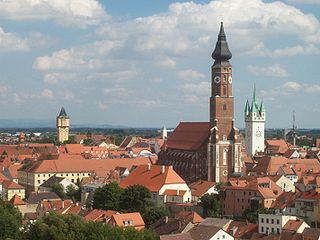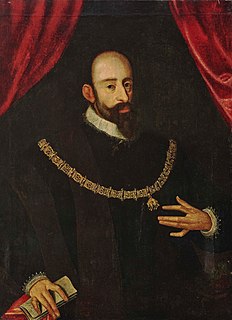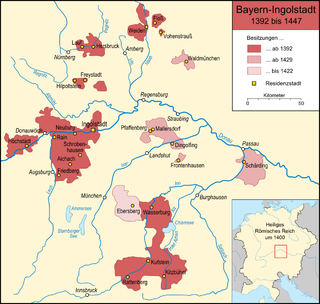
Abensberg is a town in the Lower Bavarian district of Kelheim, in Bavaria, Germany, lying around 30 km southwest of Regensburg, 40 km east of Ingolstadt, 50 northwest of Landshut and 100 km north of Munich. It is situated on the river Abens, a tributary of the Danube.

The House of Wittelsbach is a German dynasty, with branches that have ruled over territories including Bavaria, the Palatinate, Holland and Zeeland, Sweden, Hungary, Bohemia, the Electorate of Cologne and other prince-bishoprics, and Greece. Their ancestral lands of the Palatinate and Bavaria were Prince-electorates, as well as the Archbishopric-Electorate of Cologne, and the family had three of its members elected emperors and kings of the Holy Roman Empire. They ruled over the Kingdom of Bavaria which was created in 1805 and continued to exist until 1918.
The history of Bavaria stretches from its earliest settlement and its formation as a stem duchy in the 6th century through its inclusion in the Holy Roman Empire to its status as an independent kingdom and finally as a large Bundesland (state) of the Federal Republic of Germany. Originally settled by Celtic peoples such as the Boii, by the 1st century BC it was eventually conquered and incorporated into the Roman Empire as the provinces of Raetia and Noricum.

Ingolstadt is a city in Bavaria, Germany, on the banks of the Danube, in the centre of Bavaria. In 2016, it had 133,638 citizens, making it the fifth largest city in Bavaria. It is part of the Munich Metropolitan Region.

Landshut is a town in Bavaria in the south-east of Germany. Situated on the banks of the River Isar, Landshut is the capital of Lower Bavaria, one of the seven administrative regions of the Free State of Bavaria. It is also the seat of the surrounding district, and has a population of more than 70,000. Landshut is the largest city in Lower Bavaria, followed by Passau and Straubing, and Eastern Bavaria's second biggest city.

Straubing is an independent city in Lower Bavaria, southern Germany. It is seat of the district of Straubing-Bogen. Annually in August the Gäubodenvolksfest, the second largest fair in Bavaria, is held.

William V, called the Pious, was Duke of Bavaria from 1579 to 1597.

Bavaria-Straubing denotes the widely scattered territorial inheritance in the Wittelsbach house of Bavaria that were governed by independent dukes of Bavaria-Straubing between 1353 and 1432; a map (illustration) of these marches and outliers of the Holy Roman Empire, vividly demonstrates the fractionalisation of lands where primogeniture did not obtain. In 1349, after Emperor Louis IV's death, his sons divided Bavaria once again: Lower Bavaria passed to Stephan II, William and Albert. In 1353, Lower Bavaria was further partitioned into Bavaria-Landshut and Bavaria-Straubing: William and Albert received a part of the Lower Bavarian inheritance, with a capital in Straubing and rights to Hainaut and Holland. Thus the dukes of Bavaria-Straubing were also counts of Hainaut, counts of Holland, and of Zeeland.

Stephen II was Duke of Bavaria from 1347 until his death. He was the second son of Emperor Louis IV the Bavarian by his first wife Beatrice of Silesia and a member of the Wittelsbach dynasty.
Henry XVI of Bavaria, , since 1393 Duke of Bavaria-Landshut. He was a son of duke Frederick and his wife Maddalena Visconti, a daughter of Bernabò Visconti.
The Battle of Zusmarshausen was fought on 17 May 1648 between Bavarian-Imperial forces under von Holzappel and an allied Franco-Swedish army under the command of Carl Gustaf Wrangel and Turenne in the modern Augsburg district of Bavaria, Germany. The allied force emerged victorious, and the Imperial army was only rescued from annihilation by the stubborn rearguard fighting of Raimondo Montecuccoli and his cavalry.

Trausnitz Castle is a medieval castle situated in Landshut, Bavaria in Germany.

Palatinate-Neuburg was a territory of the Holy Roman Empire, founded in 1505 by a branch of the House of Wittelsbach. Its capital was Neuburg an der Donau. Its area was about 2,750 km², with a population of some 100,000.

Bavaria-Ingolstadt was a duchy which was part of the Holy Roman Empire from 1392 to 1447.

Bavaria-Landshut was a duchy in the Holy Roman Empire from 1353 to 1503.

Burghausen Castle in Burghausen, Upper Bavaria, is the longest castle complex in the world, confirmed by the Guinness World Record company.
Margaret of Brandenburg was a Princess of Brandenburg by birth and through successive marriages Duchess of Mecklenburg, Duchess of Bavaria-Ingolstadt and Countess of Waldenfels.
The Bavarian War from 1420 to 1422, also known as the Great War of the Lords, was a conflict between Louis VII the Bearded of Bayern-Ingolstadt and Henry XVI of Bavaria-Landshut. The conflict overshadowed Louis VII's reign, which lasted more than thirty years.

Sandersdorf Castle is a castle, or stately house, in the village of Sandersdorf in Altmannstein, to the northeast of Ingolstadt, Bavaria, Germany. The present building dates to 1646, and was restored in 1900.














